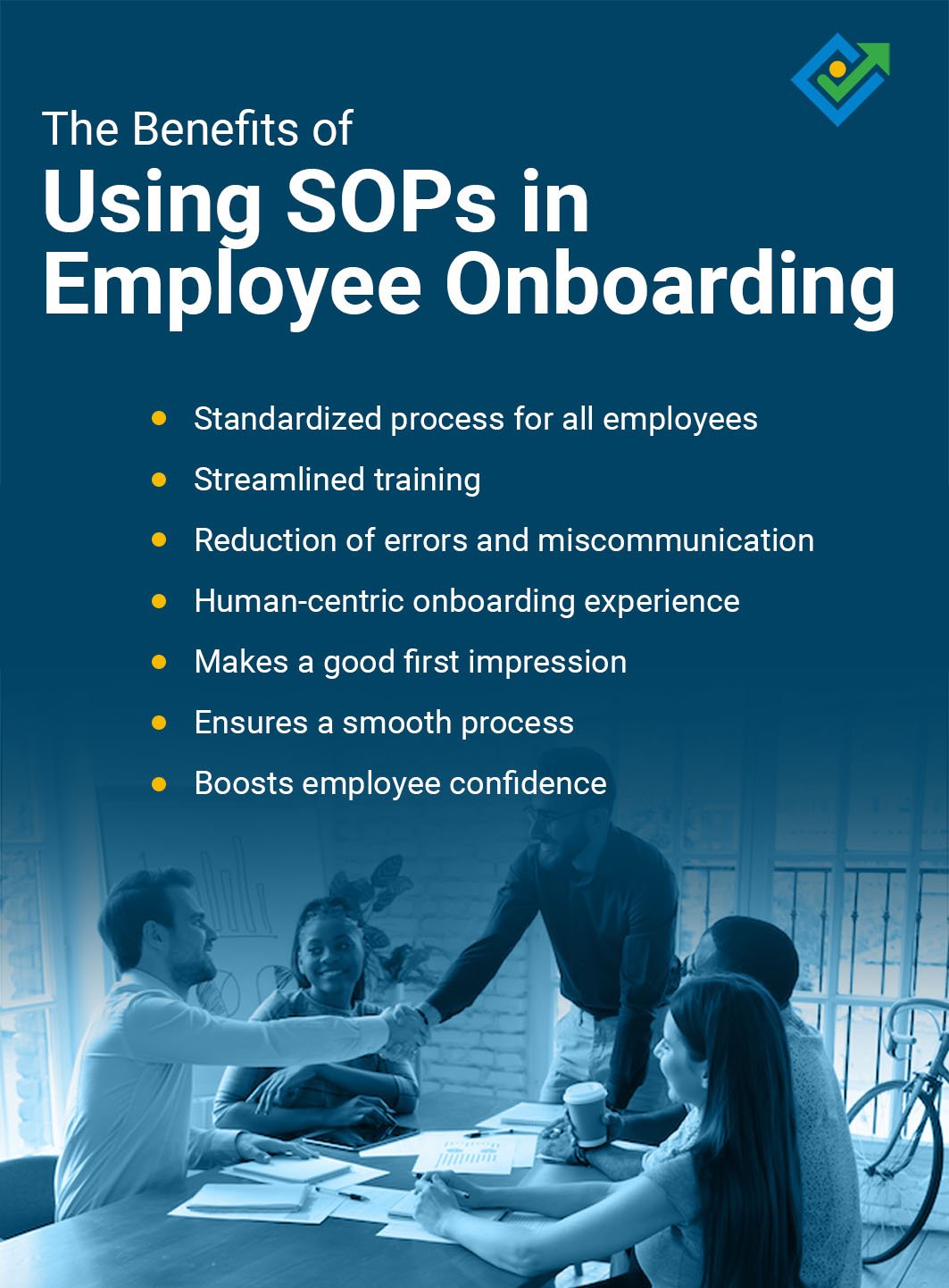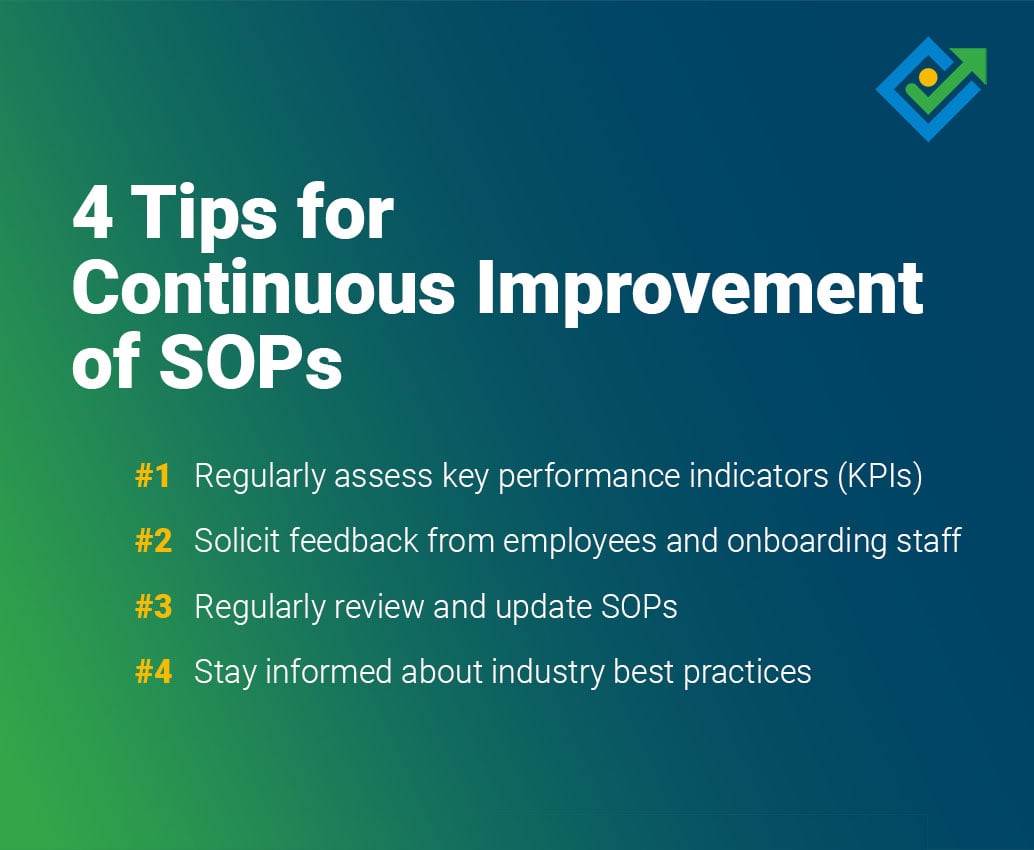
Standard operating procedures (SOPs) for employee onboarding can assist in a smooth transition when joining a new company. Using SOPs to onboard new hires is like having a reliable roadmap — it keeps everyone on the same page and helps the entire team speak the same language from day one through a structured onboarding process.
Employee onboarding is an essential process, and it's important to get it right.
According to studies done by Behavioral Technologies, Inc., on average, 25% of the annual salary of a new hire for a new position is spent in knowledge transfer, including orientation, learning about the workplace and coworkers, ramp-up time, productivity loss while learning, and errors and rework.
The Benefits of Using SOPs in Employee Onboarding
Onboarding SOPs provide a structured framework that ensures consistency, efficiency, and understanding of company policies and procedures for new employees.

Other benefits include:
Standardized process for all employees
Of course, there are nuances for different roles, but a lot of onboarding is common for all employees. It's important that everyone gets onboarded the same way. A standardized, structured framework is easier for HR teams to update. Consistency eliminates uncertainties, providing necessary resources and a structured introduction to your organization, its values, and expectations.
Streamlined training
SOPs streamline the training process, enabling employees to reach peak productivity faster. With clearly defined procedures and expectations, new hires can focus on learning key tasks and responsibilities, reducing the time it takes to integrate into their roles.
Reduction of errors and miscommunication
Clearly outlined procedures leave little room for misunderstanding or mistakes, minimizing the risk of errors in necessary steps that could impact both individual performance and team dynamics. A well-written SOP provides a step-by-step guide for your new employee.
Human-centric onboarding experience
When employees are welcomed into an environment with clear processes and expectations, they feel more supported, leading to excitement and a sense of belonging. This positive onboarding experience not only boosts productivity but also contributes to the long-term fulfillment and engagement of valuable team members, increasing employee retention.
Makes a good first impression
Effective onboarding is also an opportunity to make a good impression on the new employee. Reinforce their choice to come work for you, contribute to a longer tenure with your organization, and reduce turnover.
Ensures a smooth process
Typically, the new employee meets with their direct supervisor first thing. But what if the supervisor isn’t equipped to train a new employee? Or what if suddenly they get pulled into an important meeting or called in sick? What are you supposed to do then?
Boosts employee confidence
Think of your first day at a new job. You probably felt overwhelmed and anxious, curious to see how the day goes. A good onboarding system helps your new employee feel confident on Day 1. A new employee won’t remember everything their supervisor covers. SOPs ensure they have something they can reference later.
Creating SOP Onboarding Documentation
Think of “New Employee Onboarding” as one of your essential systems
Instead of just writing up documents that apply to onboarding, why not create a turn-key onboarding system that is intentionally designed to energize the new hire and set them up for long-term success? If you adopt that mindset, you’ll be successful.
Implementing a well-designed system can significantly reduce their ramp-up time while also helping other team members prepare. Our clients have reported up to a 50% reduction in new employee ramp-up time when using our Zavanta SOP software for onboarding.
Some important SOP categories every onboarding should include:
An effective onboarding process should include everything your new team member needs and address what others involved in onboarding need to do. This might include:
- Running pre-hire background checks
- How to set up the employee’s computer system
- SOPs related to Human Resources policies such as Code of Conduct, Whistle-blower, and the employee handbook
- Security SOPs (and related policies)
- Signing up for payroll, and employee benefits like healthcare insurance and 401k
- Operational SOPs such as reporting expenses or requesting time off
- How to access key applications (SOPs about your company’s tech stack)
- How to add the employee to key systems like Teams, Slack, and Zoom
Related information:
- Company dictionary
- Getting technical support
- Job-specific and department-specific SOPs
All content should be tagged or filterable by role, job title, or grade so it's easy to pull out the training process that is relevant for each position in your entire organization. You’ll have content that applies to all employees and then position-specific content. If you structure your content properly, you won’t have to repeat policies and procedures that apply to everyone.
How to Create an Effective Onboarding Program with SOPs
Even in the smallest of organizations, knowing how to create a good onboarding system and making sure it includes the relevant information users need can be overwhelming. So, let’s break it down.
- Map out the critical path (Onboarding Process). This involves a comprehensive look at all tasks and activities involved in bringing a new employee into the organization. Start by reviewing the hiring steps, such as paperwork completion, introduction to company culture, performing a background check, and initial training sessions. Think about the entire process and who does what and when. This exercise will also help you determine what information is general, applies to everyone, and what information is job-specific.
- What does the employee need to do?
- What does HR do?
- What does their supervisor do?
- What does IT do?
- Make a list. A picture or flow chart here helps.
- Break the process down into step-by-step procedures. This documentation should be detailed and specific, providing a clear roadmap and necessary information for both onboarding staff and new employees. Each process step will be broken down into procedures with step-by-step instructions.
- Link to company policies and standards. New hires need to be well-versed in values, rules, and expectations from the outset. Policies need to be linked to related SOPs. You may also have LMS courses the employee should attend that educate them on key policies.
- Link any onboarding documents or paperwork into the procedures at their point of use.
- Turn the process into a checklist. This way, each person involved in the process can check off when they complete their part. The employee’s supervisor can, at any time, see where things are in the process. “Oh, Ted is 50% through his onboarding, great!”
- Test your onboarding system and tweak it. Before you use your onboarding system the first time, have team members take it for a dry run. Notice where they have trouble or have questions. Change your system as needed. There may be employees who need a refresher on specific SOPs or policies. Use them as your testers.
- Put the system into action. Launch your system. There are probably tasks and SOPs that need to be done before your new employee starts. Once the new employee starts, walk them through your system so they know what to expect.
- Checklist completed! Once all the tasks are completed, your new employee will have access to all the SOPs and policies in case they need a refresher. At this point, they will also have access to the SOPs they need to perform their job every day.
Tips for creating highly useful onboarding SOP documents
Hopefully, you are not starting from zero, but it is likely you and your team have many new procedures to write. You might consider starting with an SOP template. Here are a few more tips to consider and share with your team:
Ensuring clarity and accessibility. The material should be presented in a user-friendly format, utilizing clear language and, where applicable, visual aids (which can include images, charts, and infographics). The goal is to make the information easily digestible for both onboarding employees and new staff. Additionally, ensuring accessibility means that the documentation is readily available when needed and usable for all employees, even those with visual impairments.
Include images, videos, and podcasts. Multimedia is excellent for reinforcing key concepts and supporting different learning styles. Include a welcome video from your CEO or show images of machinery or screenshots from software programs. Our client, Morey's Piers, includes images of amusement park ride control panels to help with onboarding their employees.
Make it easy to collect feedback. Let users rate documents. Attach feedback surveys so that employees can provide comments. New employees are a great resource for suggestions and new ideas since they come into your organization with a fresh outlook.
Integrate your work culture SOP onboarding documents. A company's culture highlights the human experience within an organization. When company culture is well-documented and communicated, companies can create a sense of belonging and purpose. Employees recognize they are seen as humans, not just another cog in the wheel, which enhances engagement and motivation.
Add links to your organization’s gurus into SOPs. Connect employees with your experts. Include their contact information in your onboarding SOPS.
Create and link SOPs to a company dictionary. New employees won’t be familiar with your organization’s jargon and terminology. A dictionary accessible to all can be an invaluable tool for new and existing employees.
Utilize technology for SOP implementation. Leveraging technology streamlines the onboarding process, making SOPs easily accessible to both onboarding staff and new employees. Digital platforms, interactive modules, and online training tools can significantly impact the learning experience and ensure that SOPs are understood, retained, and easily accessible.
Overcoming Challenges in Onboarding SOP Implementation
Of course, implementing SOPs can sometimes bring challenges. Subject matter experts may resist because they say they do not have time to write SOPs. Even senior leadership may resist. Below are a few ideas to handle these hurdles:
Resistance to change: Employees may be accustomed to “what we’ve always done” and may view the introduction of SOPs and checklists as disruptive – even though you know this will be beneficial. Overcoming this challenge requires effective communication, highlighting the benefits of SOPs, and involving employees in the development process. Make sure you effectively answer the question, “What’s in it for me” for every stakeholder. The more effective your onboarding is, the fewer problems and questions they’ll encounter down the road.
Keeping SOPs updated: Perhaps the largest challenge in onboarding SOP implementation is outdated information that can lead to confusion and inefficiencies. Recognizing SOPs should be treated as living documents and proactively establishing a dedicated process for maintenance, including reviewing and updating, is essential.
Adapting to individual employee needs: A one-size-fits-all approach may not cater to the unique strengths and preferences of each team member. Overcoming this challenge involves striking a balance between standardization and flexibility – while onboarding SOPs offer a framework of consistency, employees should be able to express their needs and have input on the training documentation.
Engage leadership: If management is skeptical, create a proof of concept (POC) and document your success. This is where your focus on business the outcome pays off. Can you show a shorter ramp-up time? Were you able to accomplish a major project faster? Make a deadline? If you can dollarize time savings and business benefits, that will go a long way to gaining buy-in from leadership.
While you may be faced with a few bumps in the road the benefits outweigh the challenges when it comes to implementing SOP onboarding documentation. Plus, there are plenty of solutions that can make the challenges less daunting – such as software like Zavanta that is specifically designed for SOPs, policies, and best practices.
Monitoring and Evaluating SOP Effectiveness
SOPs for onboarding should be continuously updated and improved. Remember, this is a living, breathing system that you can use repeatedly with each new employee who comes through the door.
Tips for Continuous Improvement of SOPs
As people use your system, you’ll discover areas of improvement.
- Regularly assess key performance indicators (KPIs). These KPIs include onboarding completion times, employee feedback, and adherence to documented procedures.
- Solicit feedback from employees and onboarding staff. Continuous feedback loops involving HR professionals, trainers, and new hires provide valuable insights into the usefulness and relevance of SOPs. Companies can take this feedback to refine their onboarding processes so that they remain efficient, employee-centric, and aligned with any evolving dynamics of the organization.
- Regularly review and update SOPs. Every organization is subject to change. Make sure your SOPs reflect those changes. Make sure it's easy to spot and track the impact of change. Which SOPs or policies are impacted? A good organizational system is invaluable here. The advantage of using an automated system is that you can set periodic review dates, and key staff members can be automatically notified.
- Stay informed about industry best practices. Onboarding processes should align with the latest standards in the industry. This alignment enhances operational efficiency and helps stay compliant with any regulatory changes. Additionally, incorporating best practices into SOPs shows adaptability and readiness to embrace innovations, contributing to the overall success and competitiveness of the organization in attracting top talent. New hires will be thrilled to join a company knowing that they are in a place where they can thrive and improve their professional skills.

Make Employee Onboarding Easier With Zavanta
You can leverage Zavanta software to make onboarding SOPs and systems easier to create, maintain, and, most importantly, use. Take your onboarding process to the next level.
Zavanta significantly reduces the time and cost across all SOP life cycle tasks, while ensuring that your SOPs are easy to find and use. Apply a checklist, and everyone can keep track of onboarding tasks and onboarding progress.
We all know how difficult it is to keep SOPs updated. Zavanta's version control and update tracking features solve the maintenance problem, ensuring that onboarding documentation evolves with the organization.
By utilizing Zavanta, organizations can enhance their onboarding experience, providing new hires with clear, accessible, and up-to-date information, ultimately contributing to a smoother and more standardized onboarding process.
Morey's Piers is an amusement park that uses Zavanta to streamline and manage operations manuals for 55 rides and attractions. These manuals are used during the employee onboarding process every year. Read the full case study.
Feel free to reach out to our team to learn more.
Additional Resources
.png?width=289&height=63&name=full%20logo%20(white).png)
